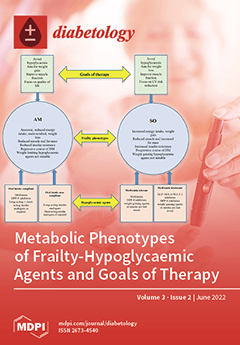Introduction: Metabolic Syndrome (MS) is a pathologic condition characterized by Type 2 diabetes mellitus (T2DM), insulin resistance, abdominal obesity, hypertension, and hyperlipidemia. Until now, specific drugs such as metformin (MET) have been used to address its individual components; however, according to the recommendation
[...] Read more.
Introduction: Metabolic Syndrome (MS) is a pathologic condition characterized by Type 2 diabetes mellitus (T2DM), insulin resistance, abdominal obesity, hypertension, and hyperlipidemia. Until now, specific drugs such as metformin (MET) have been used to address its individual components; however, according to the recommendation of WHO, various plant extracts might be used as alternative medicines due to the side effects of pharmacologic agents. Policaptil Gel Retard
® (PGR), a macromolecule complex based on polysaccharides which slows down the absorption rates of carbohydrates and fats, proved effective against glucose abnormalities. Our study aimed to verify the short-term efficacy and safety of PGR under real-life conditions. Methods: We evaluated both the 6-month changes in metabolic parameters in Italian patients with MS and T2DM, and the 10-year CV risk score (10-y-CV-RS) from the CUORE equation, competitively randomized to Policaptil Gel Retard (2172 mg before each main meal); Group A,
n = 75, or Metformin (1500–2000 mg/day equally divided between the two main meals), and Group B,
n = 75. Results: Fasting plasma glucose and HbA1c decreased significantly and similarly (
p < 0.001) in the two groups. A significant decrease in BMI (−20% in the PGR group (
p < 0.01), −14.3% in the MET group (
p < 0.05)), % visceral fat, and UA levels was also apparent in both groups (
p < 0.01). The opposite occurred for lipid profile, which improved significantly in the PGR group but remained unchanged in the MET group. Consequently, only the PGR group experienced a significant decrease in the 10-y-CV-RS (31.4 ± 8.0 vs. 19.7 ± 5.2,
p < 0.0001), whereas this remained unchanged in the MET group (32.2 ± 3.3 vs. 30.5 ± 8.7; p n.s.). Conclusions: PGR could represent a suitable alternative to MET as a first-line treatment option, especially now that an ever-increasing number of people prefer natural products based on plant extracts. This is particularly pertinent given that, besides trying to avoid gastrointestinal side-effects as much as possible, patients might be sensitive to ecotoxicology-related problems involving plants and animals caused by the worldwide spread of environmental MET metabolites.
Full article





